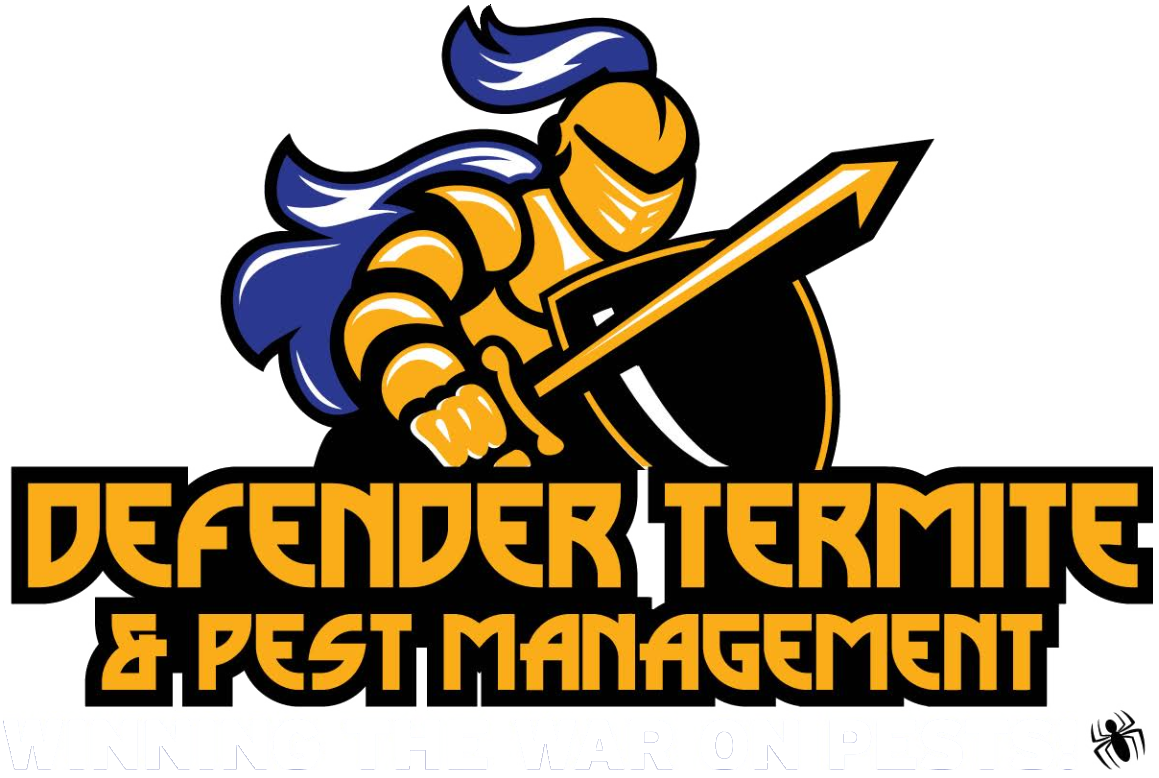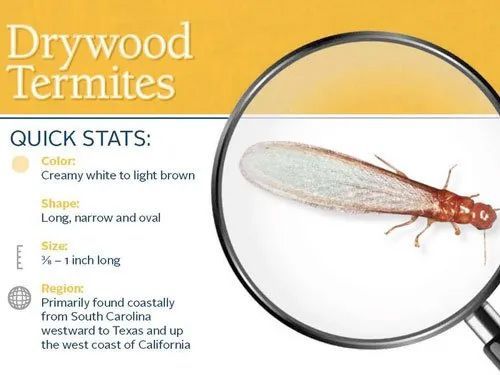Termite Library
Termite Control Services
PEST FREE GUARANTEE
Contact Us Today For A Free Estimate
Drywood Termites
Drywood termites are more prevalent in Southern California, but also occur along most coastal regions and in the Central Valley. Drywood termites have a low moisture requirement and can tolerate dry conditions for prolonged periods. They remain entirely above ground and do not connect their nests to the soil. Piles of their fecal pellets/droppings, which are distinctive in appearance, may be a clue to their presence. The fecal pellets are elongate (about 3/100 inch long) with rounded ends and have six flattened or roundly depressed surfaces separated by six longitudinal ridges.
They vary considerably in color, but appear granular and salt and pepper like in color and appearance. Winged adults of western drywood termites are dark brown with smoky black wings and have a reddish brown head and thorax; wing veins are black. These insects are noticeably larger than subterranean termites.
Drywood Termites, may require tenting/fumigate the entire building. Depending on the physical shape of the structure, this can be quite difficult. Other methods such as Orange Oil treatments may also be used but may not be as affective. Drywood termites do not (naturally) survive in the temperate zone. Drywood termites can, however, be imported from their native habitats, often in furniture and other wooden or decorative items. (section “1″ category pest / Structural Pest Control).
Subterranean Termites
The western subterranean termite, is the most destructive termite (section “1″ category pest / Structural Pest Control) found in California. Reproductive winged forms of subterranean termites are dark brown to brownish black, with brownish gray wings. Subterranean Termites are smaller than Drywood termites, approximately one-fourth inch long. They create colonies in the soil and require moisture to survive. Unlike Drywood Termites, they do require a direct connection to soil. They build tubes up the side of concrete foundations or straight out of the ground, making highway tunnels for traveling to their food source and back.
The western subterranean termite, is the most destructive termite (section “1″ category pest / Structural Pest Control) found in California. Reproductive winged forms of subterranean termites are dark brown to brownish black, with brownish gray wings.
Subterranean Termites are smaller than Drywood termites, approximately one-fourth inch long. They create colonies in the soil and require moisture to survive. Unlike Drywood Termites, they do require a direct connection to soil. They build tubes up the side of concrete foundations or straight out of the ground, making highway tunnels for traveling to their food source and back.
Subterranean termite is the most destructive species of subterranean termites. Another destructive species in this group, the Formosan subterranean termite, is now in California but restricted to a small area in the southern portion of the state. Unlike the western subterranean termite, Formosan subterranean termitesswarm at dusk and are attracted to lights.
Subterranean termites require moist environments. To satisfy this need, they usually nest in or near the soil and maintain some connection with the soil through tunnels in wood or through shelter tubes they construct. These shelter tubes are made of soil with bits of wood or even plasterboard (drywall). Much of the damage they cause occurs in foundation and structural support wood. Because of the moisture requirements of subterranean termites, they are often found in wood that has wood rot.
Carpenter Ants
The black carpenter ant is a common invader of homes at the California. They normally nest in logs, stumps, and hollow trees. However, the large, dark-colored workers often invade homes. Carpenter Ants don’t eat wood, but they sure like to make it their home. They bore into wood framing and even wood cabinets to make their nests. They do cause structural damage but are usually noticed by home owners during swarming season when huge black flying ants are all over the place. They are about 3/4 of an inch in length. These ants seldom tunnel into dry, sound wood, but they may excavate moist, rotting woods to make the nests.
Rarely will the expansion of a nest into a building’s wooden timbers cause structural damage (section 1 category pest / Structural Pest Control).
Locally Owned
24/7 Emergency Services
Carpenter Bees
Carpenter bees don't eat wood or material, but rather they bore into it. These wood boring pests can cause a lot of damage to your property. They are most active in the spring after hibernation and then they go to work on their nests. Also referred to as boring bees, they look for softer wood to nest in like pine, redwood, cedar, etc. They are not picky when it comes to dry wood or painted wood as either will work for nesting. From there they build tunnels and small cavities that overtime can compromise the wood and cause a lot of damage to your home.
Dry Rot Fungus
Dry rot (section “1″ category: Structural Wood Destroying Organism) , is the cause of sever timber decay in buildings. Described as a brown rot, it often occurs in damp timber which is un vented space and in contact with, or embedded in, wet brickwork or masonry. The fungus is sensitive to high temperatures, air movement and rapid drying. Exposed timbers and timbers where there is good ventilation are rarely affected. Affected timber takes on a very dull brown color, mostly developing deep cracks along and across the grain. The timber loses weight and will crumble between the fingers. The dry rot fruit body is often found on a timber to wall joint, this can sometimes be a reaction to unfavorable conditions
The body is quite tough and fleshy to feel, and develops a pancake like shape. The center is a yellow ochre when it is young and this develops to a deep rust color when it is older. The deepening in color is a result of the fine, brown spores it produces which are generally gathered in a dust below the body. The edges of the fruit body will be white or grey. The fruit body may be the first visible sign of dry rot out break
Beetles
Powder Post Beetles are found in a variety of wood products. They infest everything from wicker baskets to hardwood floors and pianos. They are usually detected by seeing very fine saw dust or little holes in wood surfaces. The holes are the openings through which the adult beetles emerge.
Powder Post beetles prefer the sapwood of oak and other hardwoods and many of the insects will continue to breed in an infested piece of wood for generations. This practice can result in an ultimate destruction of the wood.
PEST Services






